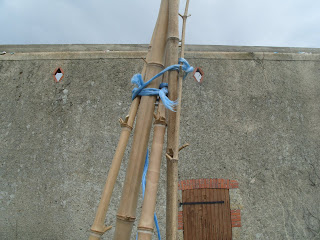So it came time to build another support for the beans, after inspiration from Sara down the road. Hubs had done the first support, made out of tent poles, but it looked, quite frankly, a miserable piece of garden architecture! But Sara's crew had made a wigman contruction out of bamboo poles, raided from a nearby field. Peyang! An idea zoomed in! Were there not bamboo stems underneath the bridge at the end of the Back Field, all lying down and nicely dried out, put there by nature from the large copse of bamboo in our neighbour's garden? Great idea. Bamboo thereby acquired. Branches lopped off, stems cut into 2 metre lengths, now off into the front garden to have a go at being a construction engineer.
I had five bamboo poles, and some string. This is what I did:
First Wigwam: Got strongest pole and shoved it into the ground as far as I could go, which was not very far. Holding this pole with one hand, I reached down to pick up another pole. Balancing the first pole on my shoulder, I jammed the other pole into the ground as far as I could, which again was not very far. I wiggled them about until they crossed over towards their tops. Ah but the string was still on the ground and I was upright trying to hold the poles together. Had to let go of them to get it.
They fell down.
But not to worry. Started again. One pole up. Two poles up. Wound a bit of string around the two of them, the idea being that this would fix them together. Then another pole. Stringed that to the others. Now had a triangle.
But a problem: where to put the other two poles. Fiddled about a bit, and here is what I ended up with:
And yes, your eyes to not deceive you: the wigam has a drunken tilt. It was dismantled.
Pow-wow with Hubs determined that one needed to make the basic construction on the ground first. He gave me specific instructions, which enabled me to construct Wigwam Two:
Lay two poles on the ground, crossing over near the top.
Wind string round them, "tight enough to hold them together firmly but not so tight that they are rigid", according to Hubs.
Now lay another pole across these two, and bind that together with the others.
Holding the construction by the roped part, pick the tripod up to be put into position in the ground. But by now the bottoms of the bamboo poles were showing signs of distress after being forcibly pushed into the soil during Wigam One's construction, so I took it upon my self to enlarge the instructions from Hubs, by making holes in the ground before inserting the poles to make a triangle:
Into which the poles were pushed:
Still following instructions, tied the remaining poles to the construction. Et voila:
But no. It was not deemed a fit construction by Hubs, who wiggled it about, said it was going to fall over, so dismantled it before it did.
Time for coffee and a re-think. And it came to me that the problem was not in the air, round the top of the poles, but on the ground. That it was the pattern of the poles at ground level which was causing the problem. Like all things, if the basics aren't right then there is no hope for success no matter what the project is, whether it be life, relationship, or a task.
So onto Wigwam Three: First made five holes in the ground:
Into which I inserted two poles:
....crossing them over at the top, and tying them together:
Putting the third pole to rest against those two, and tying that one in as well:
Then the other two poles, putting them where they best fitted.
Voila: Wigwam Three, plus Bools who is pretending not to be interested:
Now all that remains to be done is for the earth to be firmed around the holes into which the poles are now sitting, wind some string between the poles to make a net effect, and plant the beans.
Things I have learnt: that keeping on making the effort will eventually bring success. That taking time to make proper preparations at ground level will ensure that what is built on top will be strong and withstand the winds, whether they be the winds of nature or the winds of life.













